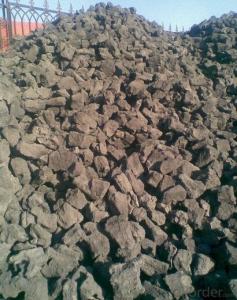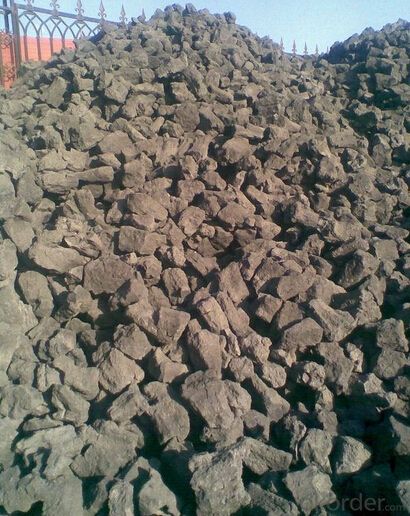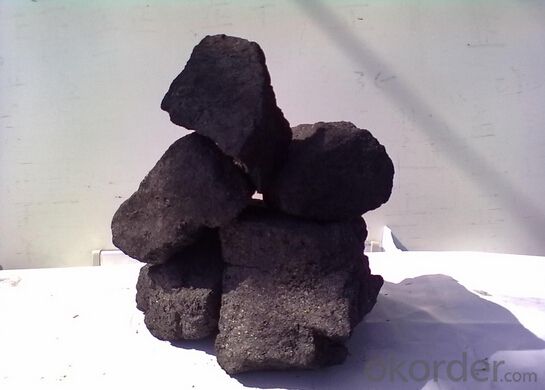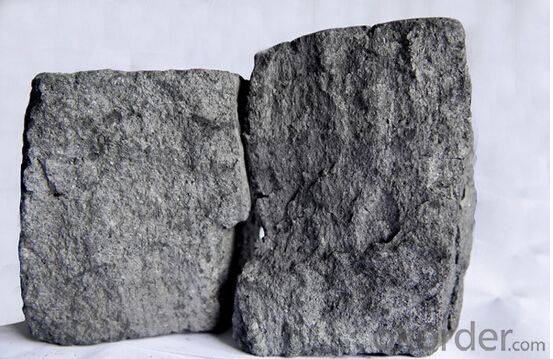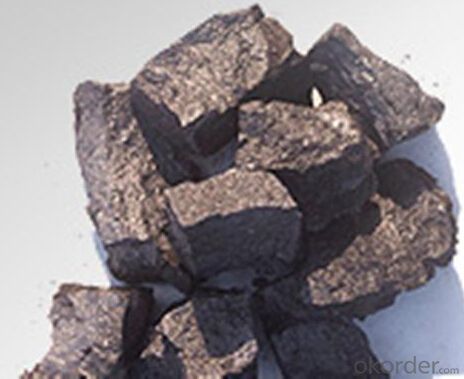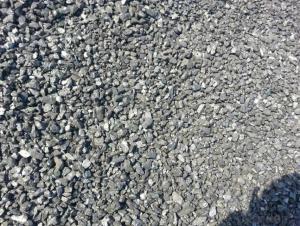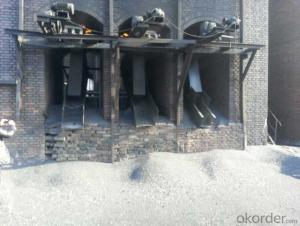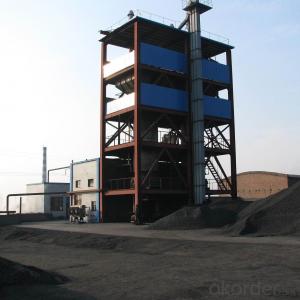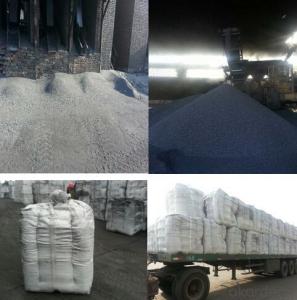Recarburizer of coke supplier Carburant
- Loading Port:
- Dalian
- Payment Terms:
- TT OR LC
- Min Order Qty:
- 10 m.t
- Supply Capability:
- 500000 m.t/month
OKorder Service Pledge
Quality Product, Order Online Tracking, Timely Delivery
OKorder Financial Service
Credit Rating, Credit Services, Credit Purchasing
You Might Also Like
Specification of Recarburizer:
Supply recarburizer 5--15mm
- Quick delivery with strong package
- Competitive price
- best seller
Recarburizer Data Sheet:
F.C | 98%MIN |
ASH | 0.3%MAX |
VM | 1.5%MAX |
S | 0.5%MAX |
SIZE | 5--15MM |
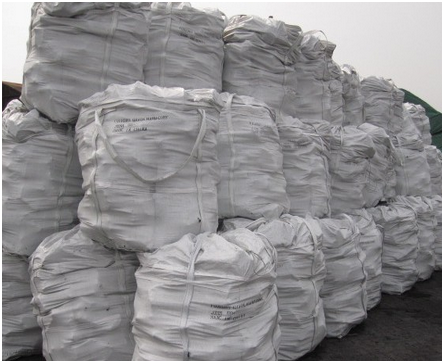

- Q: What kinds of barbecue carbon do you have?
- The disadvantage is more expensive. Ordinary charcoal advantages are cheap, disadvantages are different sizes, barbecue uneven fire, burning time is short, the process of baking carbon must be added. The mechanism of carbon is actually a mixture of carbon and coal, pressed into the multi hollow prism, from carbon containing ash on the look out the composition of coal.
- Q: How is carbon used in the production of carbon nanomaterials?
- Carbon is essential in creating carbon nanomaterials due to its role as the foundation for their distinct structure and properties. Various techniques are employed to manufacture carbon nanomaterials, including carbon nanotubes and graphene, all of which rely on manipulating and organizing carbon atoms. One commonly used method for producing carbon nanomaterials is chemical vapor deposition (CVD). In this process, a carbon-containing gas, such as methane or ethylene, is introduced into a high-temperature furnace. Within the furnace, the gas decomposes, releasing carbon atoms. Subsequently, these carbon atoms reform and create nanoscale structures, like carbon nanotubes or graphene, on a substrate or catalyst material. Another approach involves vaporizing carbon-containing compounds, such as carbon black or graphite, through techniques like laser ablation or arc discharge. The vaporized carbon then undergoes condensation and solidification, resulting in carbon nanomaterials with specific structures and properties. Both methods allow for precise manipulation of carbon atoms by controlling temperature, pressure, and the presence of catalysts or additives. This manipulation leads to the desired carbon nanomaterials, which possess exceptional mechanical, electrical, and thermal properties due to the unique arrangement of carbon atoms, such as the hexagonal lattice structure of graphene or the cylindrical structure of carbon nanotubes. In conclusion, carbon is a crucial element in carbon nanomaterial production, providing the necessary atoms and influencing their structure and properties. Understanding and controlling carbon's behavior at the atomic level empower scientists and engineers to develop nanomaterials with diverse applications, ranging from electronics and energy storage to medicine and environmental remediation.
- Q: How does carbon contribute to the strength of composite materials?
- Carbon contributes to the strength of composite materials through its exceptional stiffness and high tensile strength properties. When carbon fibers are embedded in a matrix material, such as a polymer resin, they provide reinforcement and help distribute loads evenly throughout the composite. This reinforcement enhances the overall strength, durability, and resistance to deformation of the composite material, making it ideal for various applications in aerospace, automotive, and construction industries.
- Q: What are the consequences of increased carbon emissions on public health systems?
- Increased carbon emissions have significant consequences on public health systems. One of the most prominent effects is the exacerbation of respiratory diseases such as asthma, chronic obstructive pulmonary disease (COPD), and bronchitis. Carbon emissions contribute to the production of fine particulate matter (PM2.5) and ground-level ozone, both of which can penetrate deep into the respiratory system and cause or worsen these conditions. Moreover, higher levels of carbon emissions are correlated with an increased prevalence of cardiovascular diseases. Fine particulate matter and other pollutants released from carbon-emitting sources can enter the bloodstream, leading to inflammation, oxidative stress, and the development of atherosclerosis. Over time, this can result in heart attacks, strokes, and other cardiovascular complications. Climate change, driven by carbon emissions, also impacts the spread of infectious diseases. Rising temperatures and altered precipitation patterns create favorable conditions for the expansion of disease vectors like mosquitoes and ticks, leading to the transmission of diseases such as malaria, dengue fever, Lyme disease, and Zika virus. Additionally, extreme weather events and natural disasters associated with climate change can disrupt healthcare infrastructure and compromise access to essential services, further impacting public health systems. Furthermore, mental health is also affected by increased carbon emissions. The environmental degradation caused by carbon emissions contributes to feelings of anxiety, stress, and depression, often referred to as eco-anxiety or climate grief. The loss of biodiversity, destruction of natural habitats, and the overall uncertainty surrounding the future can have detrimental effects on individuals and communities, requiring additional resources and support from public health systems. In summary, increased carbon emissions have far-reaching consequences on public health systems. They contribute to the prevalence of respiratory and cardiovascular diseases, facilitate the spread of infectious diseases, and impact mental health. Addressing carbon emissions and implementing sustainable practices are essential to mitigating these consequences and safeguarding the well-being of individuals and communities.
- Q: What is the structure of a diamond, a form of carbon?
- A diamond, which is a form of carbon, has a crystal lattice structure. In this arrangement, each carbon atom is covalently bonded to four other carbon atoms, forming a tetrahedral arrangement. This creates a repeating pattern and a three-dimensional network of carbon atoms. The bonds between the carbon atoms are incredibly strong, which is why diamonds are so hard and durable. The carbon atoms in a diamond are arranged in a cubic crystal system, specifically the face-centered cubic (FCC) structure. In this system, each carbon atom is surrounded by eight neighboring carbon atoms, resulting in a dense and tightly packed structure. The strong covalent bonds and compact arrangement of carbon atoms in the diamond lattice give diamonds their unique properties. These properties include exceptional hardness, high thermal conductivity, and optical brilliance.
- Q: How do carbon emissions contribute to extreme weather events?
- Extreme weather events are influenced by carbon emissions, which contribute to climate change. When greenhouse gases like carbon dioxide are released into the atmosphere, they trap heat from the sun and cause the Earth's average temperature to rise. Human activities such as burning fossil fuels, deforestation, and industrial processes are major drivers of this phenomenon known as global warming. As the planet warms, weather patterns become disrupted, leading to an increase in extreme weather events. Carbon emissions play a role in this process in several ways: 1. Heatwaves: Higher carbon emissions result in increased temperatures, leading to more frequent and intense heatwaves. These prolonged periods of extreme heat pose risks to human health, agriculture, and ecosystems. 2. Hurricanes and tropical storms: Carbon emissions cause ocean temperatures to rise, providing more energy to fuel hurricanes and tropical storms. This leads to stronger storms with higher wind speeds and heavier rainfall, causing more destruction and flooding. 3. Droughts: Climate change caused by carbon emissions can disrupt precipitation patterns, resulting in decreased rainfall and increased droughts in certain regions. These prolonged periods of water scarcity have severe impacts on agriculture, water supplies, and ecosystems. 4. Heavy rainfall and flooding: Global warming intensifies the water cycle, leading to more evaporation and moisture in the atmosphere. This results in heavier rainfall events, increasing the risk of flooding and flash floods. 5. Wildfires: Climate change, driven by rising temperatures and drier conditions, creates favorable conditions for wildfires. Carbon emissions contribute to longer and more severe fire seasons, leading to more extensive and destructive wildfires. It's important to note that while carbon emissions contribute to extreme weather events, they are not the sole cause. Natural climate variability factors like El Niño and La Niña can also influence extreme weather. However, reducing carbon emissions and transitioning to cleaner energy sources can help mitigate the impacts of climate change and prevent further exacerbation of extreme weather events.
- Q: How is carbon stored in the Earth's crust?
- Various forms of carbon are stored in the Earth's crust through different geological processes. One primary method of storage involves the creation of sedimentary rocks like limestone, dolomite, and chalk. These rocks consist mainly of calcium carbonate, which comes from the shells and skeletons of marine organisms that existed millions of years ago. As time passes, these remains gather on the ocean floor and become compressed and cemented, effectively trapping carbon within them. Another way carbon is stored in the Earth's crust is through carbonation. Carbon dioxide (CO2) from the atmosphere can dissolve in water and react with specific minerals, like basalt, leading to the formation of carbonate minerals such as calcite or magnesite. This natural process occurs through chemical weathering and volcanic activity, aiding in the sequestration of carbon within the Earth's crust. Moreover, organic carbon takes the form of fossil fuels, including coal, oil, and natural gas. These fuels are the remnants of ancient plants and microorganisms that lived and perished millions of years ago. Over time, the organic matter becomes buried and subjected to high pressure and temperature, resulting in a process known as diagenesis, which eventually converts it into fossil fuels. These deposits serve as carbon reservoirs within the Earth's crust. In summary, the Earth's crust acts as a significant carbon sink, efficiently storing carbon through processes such as the formation of sedimentary rocks, carbonation, and the accumulation of fossil fuels. However, it is crucial to note that human activities, particularly the combustion of fossil fuels, are releasing substantial amounts of stored carbon into the atmosphere, contributing to global climate change.
- Q: What are the properties of carbon-based adhesives?
- Carbon-based adhesives have several properties that make them versatile and widely used in various industries. Firstly, carbon-based adhesives are known for their excellent bonding strength. They have the ability to create strong and durable bonds between different materials, including metals, plastics, ceramics, and composites. This makes them suitable for applications where a reliable and long-lasting bond is required. Another important property of carbon-based adhesives is their high temperature resistance. They can withstand extreme temperatures without losing their adhesive properties, making them ideal for applications in high-temperature environments. This property also allows carbon-based adhesives to be used in industries such as aerospace and automotive, where components are subjected to elevated temperatures. Carbon-based adhesives also possess good chemical resistance, meaning they can withstand exposure to various chemicals without degradation. This property makes them suitable for use in industries where adhesives may come into contact with solvents, fuels, or harsh chemicals. Additionally, carbon-based adhesives exhibit excellent electrical conductivity. This property allows them to be used in applications where electrical or thermal conductivity is required, such as in the electronics industry. Furthermore, carbon-based adhesives often have low shrinkage and low outgassing characteristics. This means that they do not significantly change in size or release volatile substances during curing, minimizing the risk of damage or contamination to surrounding materials. Overall, carbon-based adhesives offer a combination of high bonding strength, temperature resistance, chemical resistance, electrical conductivity, and dimensional stability, making them a preferred choice in various industries where reliable and durable bonding solutions are needed.
- Q: How do human activities contribute to carbon emissions?
- Human activities contribute to carbon emissions in several ways. The burning of fossil fuels for electricity, transportation, and industry is one of the main sources of carbon dioxide emissions. When we burn coal, oil, or natural gas, carbon is released into the atmosphere. Additionally, deforestation and land-use changes also contribute to carbon emissions. Trees play a crucial role in absorbing carbon dioxide, so when forests are cleared for agriculture or urbanization, the stored carbon is released back into the atmosphere. Moreover, industrial processes such as cement production and chemical manufacturing also release carbon emissions. Finally, human activities like agriculture and livestock farming can produce methane, a potent greenhouse gas that contributes to global warming. Overall, our reliance on fossil fuels, deforestation, industrial processes, and certain agricultural practices all contribute to carbon emissions, exacerbating the problem of climate change.
- Q: How does carbon dioxide affect the formation of clouds?
- Cloud formation is significantly influenced by carbon dioxide in Earth's climate system. This is because carbon dioxide acts as a greenhouse gas, trapping heat in the atmosphere and causing a global increase in temperatures. This rise in temperature affects various atmospheric processes, including the formation of clouds. One of the main ways carbon dioxide impacts cloud formation is by affecting the water cycle. Increased levels of carbon dioxide lead to warmer temperatures, which result in more water evaporating from the Earth's surface. This increased evaporation leads to a higher amount of water vapor in the atmosphere, which is essential for the formation of clouds. In addition, carbon dioxide indirectly influences cloud formation by influencing atmospheric stability and the vertical movement of air. Higher concentrations of carbon dioxide can change the temperature profile of the atmosphere, causing the lower atmosphere to warm more than the upper atmosphere. This temperature difference can alter air density, causing air to rise or sink. Rising air promotes cloud formation, while sinking air inhibits it. Moreover, carbon dioxide affects the size and properties of cloud droplets. Increased concentrations of carbon dioxide can result in changes in the microphysical properties of clouds, such as smaller droplet size and concentration. Research suggests that higher carbon dioxide levels may impact cloud lifetime and precipitation patterns. It is important to note that the relationship between carbon dioxide and cloud formation is complex and remains an active area of research. Scientists are continuously studying the intricate interactions between atmospheric gases, cloud formation, and climate change to gain a better understanding of the future implications of carbon dioxide emissions on cloud dynamics and the overall climate system.
Send your message to us
Recarburizer of coke supplier Carburant
- Loading Port:
- Dalian
- Payment Terms:
- TT OR LC
- Min Order Qty:
- 10 m.t
- Supply Capability:
- 500000 m.t/month
OKorder Service Pledge
Quality Product, Order Online Tracking, Timely Delivery
OKorder Financial Service
Credit Rating, Credit Services, Credit Purchasing
Similar products
Hot products
Hot Searches
